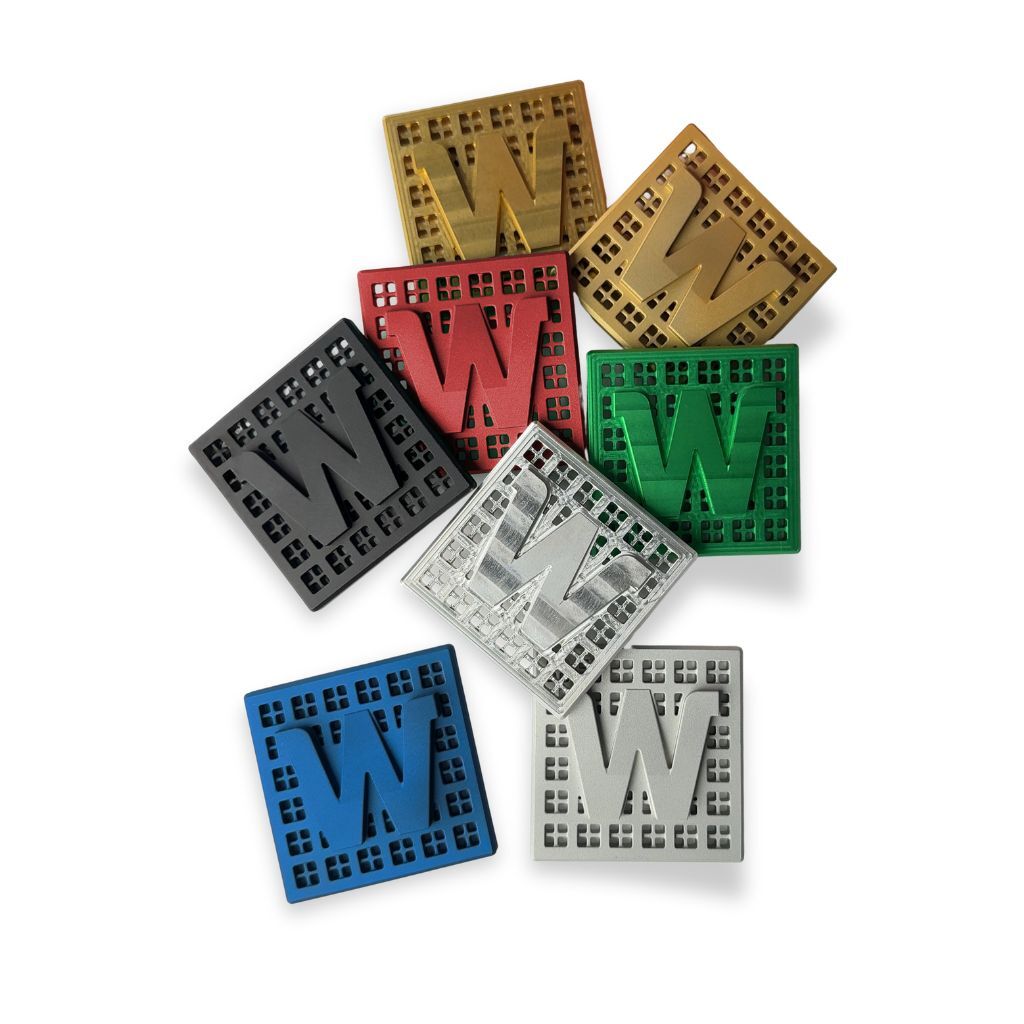Decorative anodic
Finishing for aluminum
Decorative anodising is an electrochemical surface finish designed to give aluminium alloys a uniform colour and protective barrier against corrosion, wear and oxidation. A controlled process generates a highly resistant ceramic oxide layer, available in a variety of colours and finishes, which enhances the appearance of components, making them ideal for industrial, architectural and design applications.

PROS
- Aesthetic improvement
- Corrosion protection
- No dimensional alteration
- Electrical insulation
CONS
- Colours depending on the alloy
- Fragility of the layer compared to hard anode
- Applicable only to aluminium and its alloys
ADVANTAGES OF ANODISING
Aesthetic improvement
Decorative anodising allows the aesthetic appearance of aluminum components to be significantly enhanced. Available in a variety of colors such as red, blue, black, green, gold, and clear, and in gloss or matte finishes, this technique allows for uniform surfaces that are pleasing to the touch and to the eye, eliminating any surface irregularities. With a choice of gloss or satin texture, it is possible to customise the final component according to specific design requirements, achieving results of high visual and perceived value.

Corrosion protection
One of the main benefits of anodising is excellent corrosion protection. The ceramic oxide layer formed during treatment forms a true protective barrier that isolates the underlying metal from the external environment. This makes the aluminum significantly more resistant to chemical attack, moisture and weathering. Such protection significantly extends the service life of treated components, making them suitable even for heavy-duty use or exposure to outdoor environments.

No dimensional alteration
Decorative anodising, unlike other surface treatments such as painting, does not significantly alter the original dimensions of the component. The resulting protective layer (generally between 10 and 15 microns) is extremely thin and comes directly from the metal substrate itself. This means that no deposits or surface buildup occur, avoiding issues related to dimensional accuracy or geometric tolerance. As a result, anodised parts retain their original dimensions and are ideal for applications requiring high dimensional accuracy.

INSTANT QUOTE FOR YOUR ANODISED PARTS
free instant quoteMATTE ANODISING
COMMENT
Decorative anodising is a specialised variation of the broader aluminium anodising process, developed to combine aesthetic needs and protective functions. To fully understand its importance, it's essential to recall that aluminium naturally forms a very thin oxide layer (approximately 2-5 nm thick) upon contact with atmospheric oxygen, providing basic protection against corrosion. Anodising exploits and enhances this natural phenomenon through controlled electrolytic passivation: the aluminium piece to be treated is connected to the positive pole of a cell (hence the term anode) and immersed in an electrolytic bath—typically sulphuric acid, though occasionally oxalic or phosphoric acids depending on the desired effect—while a lead or titanium bar usually serves as the cathode.
When a voltage is applied, O²⁻ ions migrate towards the metal's surface, reacting with Al³⁺ ions diffusing outward from within the metal, forming a porous, hard, and adherent aluminium oxide (Al₂O₃) layer. Initial porosity is crucial as it allows the pores to be impregnated with organic dyes, inorganic pigments, or metallic deposits (known as two-stage electrolytic colouring). Once the desired thickness is achieved—typically 10 µm for indoor components and 20 µm or more for outdoor applications—the piece undergoes sealing, either in boiling deionised water or nickel fluoride solutions, hydrating, expanding, and permanently closing the pores. This sealing retains the colour and makes the oxide layer resistant to attack.
Compared to bare metal, the anodised layer acts as a physical-chemical barrier, significantly increasing surface hardness, reducing friction, enhancing the adhesion of primers, adhesives, and paints, and importantly, providing excellent electrical insulation. This latter property, often overlooked in everyday use, is crucial in electronics and mechatronics, limiting charge accumulation and reducing the risk of electrostatic discharge (ESD) that could damage sensitive components.
Decorative Anodising: Matte and Glossy
At Weerg, decorative anodising is offered in two distinct finishes: matte and glossy. In both cases, the protective thickness remains constant, but the mechanical pre-treatment differs, altering the final appearance. With matte anodising, components undergo bead blasting before chemical processing: this micro-blasting evens out the surface, softening machining marks and creating a uniform, satin-like finish free from visual imperfections. Conversely, the glossy version does not include bead blasting, highlighting the component's lines and tool marks. Both finishes are available in red, blue, black, green, transparent (natural) and gold.
Advantages of decorative anodising:
-
Corrosion resistance
The Al₂O₃ layer is chemically inert in neutral and moderately acidic environments, offering protection from rain, sweat, saline humidity, and many household detergents. -
Increased hardness and wear resistance
Anodised surfaces resist scratches and abrasions better than untreated aluminium, extending the life of handles, profiles, bicycle parts, and smartphones. -
Electrical insulation and anti-ESD
The dielectric breakdown strength of aluminium oxide exceeds 30 V/µm, easily surpassing 600 V at 20 µm thickness. This allows the use of conductive chassis without risk of short circuits, managing charge dissipation in a controlled manner. -
Unchanged weight
Unlike paints and organic coatings, the oxide layer derives from the substrate itself, adding no external layers and eliminating delamination risks. -
Environmental compatibility
The main electrolyte is sulphuric acid, which is recyclable; VOC emissions are zero, and the finished piece remains 100% recyclable as aluminium.
Disadvantages and limitations
-
Alloy dependence
The presence of copper, silicon, manganese, or magnesium influences pore size and dye acceptance; some 2000 or 7000 series alloys rich in copper/magnesium naturally produce a brownish undertone, affecting lighter colours. -
Layer brittleness
Increased hardness can introduce brittleness; localised impacts may chip or cause micro-cracking, initiating subsurface corrosion.
Influence of alloy on final colour
Often underestimated during design, alloy composition significantly affects the final colour. Since the oxide originates from the substrate, alloying elements remain trapped or oxidise concurrently, imparting a distinct undertone.
Applications
-
Consumer electronics: Laptop cases, smartphones, headphones; anodised aluminium is synonymous with high-tech design due to its lightweight, ESD insulation, and premium tactile quality.
-
Architecture: Window frames, curtain walls, ventilated cladding benefit from weather resistance and stable colour ranges.
-
Automotive and motorsports: Gear knobs, pedals, brake pumps; racing applications often use "anodised blue" tubing (6000 series) and red quick-release fittings for rapid visual coding.
-
Aerospace: Aircraft components require electrical insulation and compatibility with structural epoxy adhesives.
-
Furniture and lighting: Lamps, LED profiles, handles benefit from a satin finish without needing paint.
-
Medical: Surgical instruments colour-coded for immediate recognition in operating theatres; the durable surface withstands autoclave sterilisation cycles.
Conclusion
Decorative anodising perfectly balances technical functionality and aesthetic value. Leveraging a mature electrochemical process, it transforms aluminium’s inherent weakness—its susceptibility to oxidation—into a strength: the artificial Al₂O₃ layer defends against corrosion, scratches, and ESD, all within just tens of microns and without adding weight. Meanwhile, controlled pigment absorption enables vibrant colour palettes and sophisticated metallic finishes. Anodising remains one of the most versatile finishing technologies available, seamlessly blending technical performance with visual appeal across industries, from architecture and consumer electronics to mobility, medical equipment, and furnishings.
Questions and answers
Decorative anodising, in the narrow sense employed by Weerg, is reserved for aluminum alloys, because only on this metal does the process produce a transparent, hard and porous Al₂O₃ layer capable of accommodating dyes. In industry, anodising variants also exist for magnesium, titanium, niobium, or zirconium, but these are used for very specific purposes (biomedical, jewellery, aerospace) and are not part of the standard offering for aesthetic finishing on CNC-machined parts.
Weerg currently offers six standard shades, selected for lightfastness and color consistency across multiple alloys:
-
Red
-
Blue
-
Black
-
Green
-
Transparent (natural)
-
Gold
All colours can be requested in both matte and glossy versions, maintaining identical protective thickness and chemical-mechanical resistance.
-
Matt: Before electrochemical treatment, the workpiece is shot peened (micro-shot peening). Shot peening evens the surface and masks milling or turning marks, generating a satin, diffusive appearance.
-
Gloss: skips the peening step, preserving the natural metallic luster; light reflects in a specular manner and some tool marks may be visible.
The oxide layer applied for aesthetic-protective purposes has a typical thickness of 10-15 microns, sufficient to ensure resistance to scratches, wear and corrosion.
3-SECOND NO-OBLIGATION QUOTE
DO YOU WANT TO TURN YOUR CNC PROJECT INTO REALITY?
Upload your 3D file to take your parts production a step further.
free instant quote









